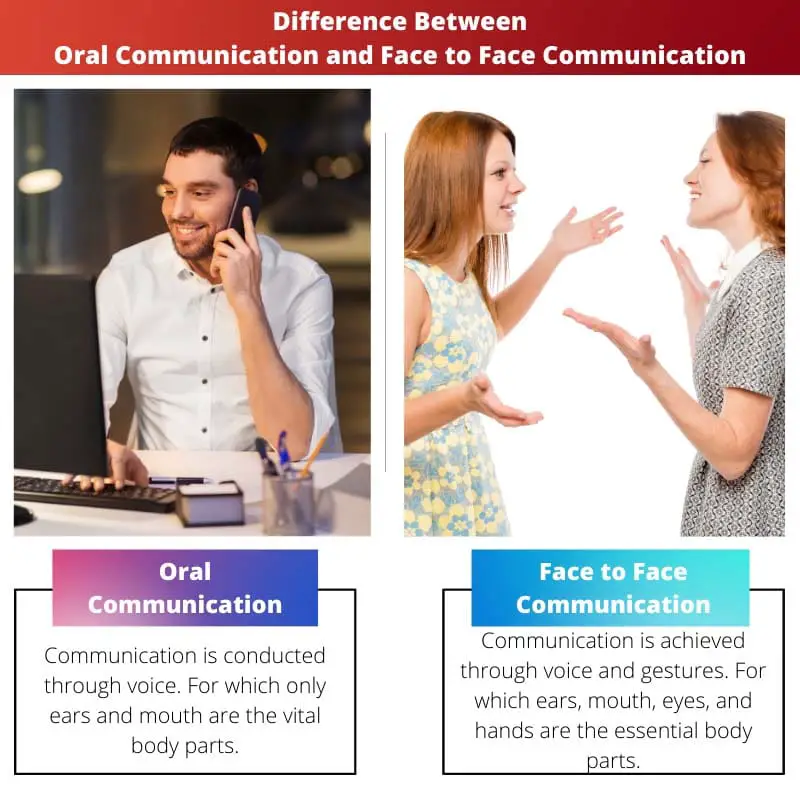Communication is transmitting information, knowledge, or message from one person, group of persons or place to another.
For communication, it is essential to have at least two parties involved, the sender and the receiver. There are different modes through which communication can take place.
Oral and face-to-face communication are the major ones.
Key Takeaways
- Oral communication refers to using spoken words to convey a message, while face-to-face communication is a type of oral communication that occurs in person.
- Oral communication can occur through various mediums, including phone calls, video chats, and podcasts, while face-to-face communication requires physical presence.
- Face-to-face communication allows non-verbal cues such as body language and facial expressions to complement spoken words, enhancing the overall message.
Oral Communication vs Face to Face Communication
The difference between oral and face-to-face communication is that the former only requires listening and talking skills. On the other hand, face-to-face communication requires seeing or watching skills and listening and speaking skills.
Along with the other differences, the two types of communication also have a few similarities.

Oral Communication is a type of communication in which the two parties- the sender and the receiver, transmit or exchange the message with their voice.
It is a style of expression in which spoken words are used. It comprises speeches, radio, telephone, video, and face-to-face conversations.
Face to Face Communication is a type of communication in which two parties- sender and receiver, transmit or exchange the message with their voice, expressions, and gestures.
It is a part of oral communication. Face-to-face communication is believed to be more helpful in building rapport and connections.
Comparison Table
| Parameters of Comparison | Oral Communication | Face-to-Face Communication |
|---|---|---|
| Organs | Communication is conducted through voice. For which only ears and mouth are the vital body parts. | Communication is achieved through voice and gestures. The essential body parts are ears, mouth, eyes, and hands. |
| Skills | Oral Communication requires hearing, listening, and talking skills. | Face to Face communication involves hearing, listening, speaking, seeing, and acting skills. There are some exceptions. |
| Equipment | To communicate orally, the two parties must be in front of each other or connected through telephone, radio, or the internet. | For face-to-face communication, the two parties must be physically or virtually in front of each other. |
| Observation | Observations can be made from the speaker’s tone, volume, pitch, and clarity. | Observations can be made from the speaker’s tone, volume, pitch, clarity, facial expressions, and physical movements. |
| Disability | Oral communication is used by people who have disabled eyesight. | Face to Face Communication is helpful for people who have disabled speaking or hearing. |
What is Oral Communication?
Oral Communication, or verbal communication, is a type of communication in which information is transmitted by voice.
It is necessary to carry out various communications, like telephonic conversations, speeches, radios, face-to-face communication, and communication with the help of the internet.
Oral communication requires the ability to speak and hear, so only the ears, mouth, and two organs are involved in this communication mode.
It requires hearing skills- to receive (hear) the delivered message, listening skills to understand (pay attention) the information being transferred and talking skills to provide specific directions.
This communication mode requires the two parties to have a telephone, radio, speaker, or face-to-face interaction, physically or virtually. In the case of Oral Communication, various observations can be made from the following factors:
1. Tone- confidence, strength, depth
2. Volume- high, medium, or low
3. Pitch– high, low, or medium and clarity of the speaker.
Some people cannot see or write, for whom face-to-face or written communication is improbable. Such people choose oral communication as their primary mode of communication.

What is Face-to-Face Communication?
Face to Face Communication is a type of communication in which information is transmitted through voice, facial expressions, and physical movements.
It is a part of oral or verbal communication. Face to Face Communication requires the ability to speak, hear, see, act and, in some cases, move.
This is why several organs are involved in this communication mode, such as ears, mouth, eyes, face, hands, and legs.
Along with hearing, listening, and talking skills, it requires watching- to observe and acting skills- to make gestures.
This communication mode requires the two parties to be face to face physically or virtually, i.e., over the internet or on video calls. In the case of Face to Face communication, observations can be drawn from the speaker’s tone, volume, pitch, and clarity and their facial expressions- happy, sad, nervous, stressed, angry or tense.
Besides that, physical movements like hand and leg movements, playing with fingers and hair or tapping one’s feet.
Some people cannot speak or hear, for whom oral communication is impossible. Such people choose face-to-face communication by using sign language as their primary mode of communication.

Main Differences Between Oral Communication and Face-to-Face Communication
- In the process of Oral Communication, the body parts involved are- the ears and mouth. While in Face to Face Communication, the ears, mouth, eyes, hands, and legs are vital body parts.
- Oral Communication requires only hearing, listening, and talking skills. But, Face to Face Communication also requires seeing and acting skills. For dumb or deaf people listening and speaking skills are not necessary.
- To have oral communication, a telephone, radio, mike, or face-to-face interaction physically or virtually are essential requirements. Whereas, in the face to face communication, only being face to face physically or virtually is a crucial requirement.
- In oral communication, observation can be made based on the speaker’s tone, volume, pitch, and clarity.
- However, in a face to face communication is based on tone, volume, pitch, clarity, facial expressions, and physical movements of the speaker.
- Oral Communication is used by people who cannot see. On the contrary, face-to-face communication is used by people who cannot hear or speak.

- https://digitalcommons.montclair.edu/psychology-facpubs/41/
- https://www.degruyter.com/document/doi/10.1515/9783110879032.181/html